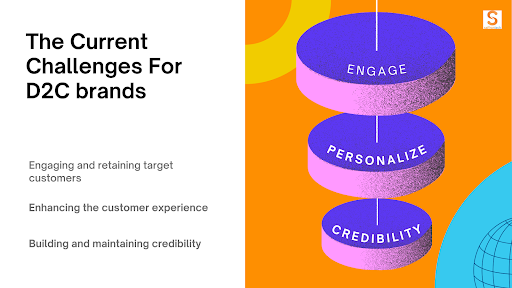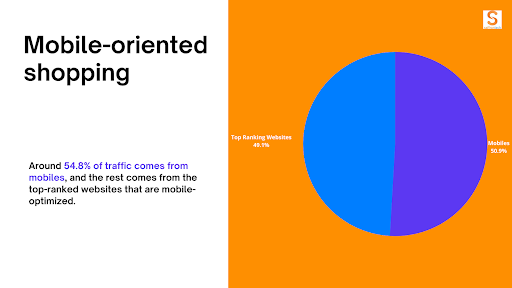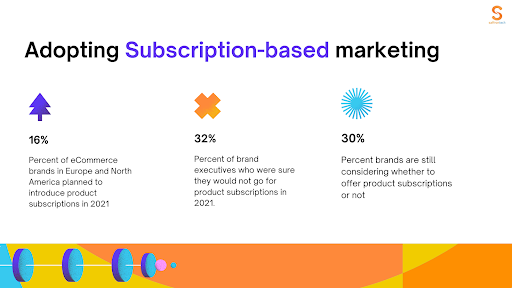There’s no doubt that the Covid-19 pandemic changed the way of doing business. Traditional retailers are now shifting their business towards direct-to-consumer (DTC) technology. Since this technology is most trusted and has a larger audience, it is easier for companies to grab bulk revenue.
Those who adopted this new era of technology and learned these new marketing strategies are now getting massive traffic on their eCommerce sites. According to a survey, eCommerce sales in 2019 accounted for 11% of total retail in the United States. And it is expected that these figures will further grow up to 15% by the end of 2021. So, it’s time to change your old marketing strategies to compete with your peers and establish your brand.
Here are the top 7 direct-to-consumer technology trends for 2022, which will surely help you boost your business.
- Omnichannel presence and support
- Effective personalization
- Mobile-oriented shopping
- Conversational marketing
- A.I. chatbots and customer communication
- Image search technology
- Seamless checkout process for reducing cart abandonment
What Are The Current Challenges For D2C brands?

When brick and mortar businesses closed in the 2020s pandemic, eCommerce protected the market giants. Companies are more engaging towards DTC technology as it becomes the sole source of connecting with a large audience and expanding your market to an infinite degree. But it’s not as easy as it is looking; there are multiple challenges, which can be a barrier to your business growth. Here are the three current D2C challenges, which you should consider:
1. Engaging and retaining target customers:
This is one of the complex tasks as they are the deciding factor of your business growth. If you are a beginner and want to grab a large audience, you need to abandon traditional marketing strategies and adopt D2C marketing strategies.
Make your website exciting and straightforward, use infographics, case studies, and top-notch content to make your website SEO-friendly. This is the best online marketing strategy to rank your website on the top Google SERPs (search engine result pages).
Apart from this, you need to offer a product subscription or newsletter to retain your previous customers, as they can add more bucks to your bank. Also, you can begin membership plans and special offers for your regular customers to retain your customers.
2. Enhancing the customer experience:
Maintaining a good reputation and creating trust is one of the challenging tasks for both beginners and big DTC giants. Not all businesses are successful in making positive reviews and feedback from customers. Only a few companies understand the importance of customer experience, and hence they get all the gems. Customer experience and feedback are just like garnishing materials that will help you to showcase your products and services beautifully to your new clients.
According to a survey by Epsilon, 80% of people purchase more from those businesses that provide personalized shopping experiences. Also, a happy client will always refer your service or product to their known persons. It will automatically boost organic traffic to your website. What can be better than this?
3. Building and maintaining credibility:
Creating trust relationships is something that most retailers lack. But on the other hand, eCommerce giants, like Walmart and Amazon, know the value of building trust between their business and customers. That is why they are on top and engaging more customers day by day.
As per a survey by ZDNet, 85% of American customers like to shop from transparent businesses. People are now more aware of the frauds, and that’s why they do not easily trust any brand.
If you want to build healthy relationships with your customers, it’s always recommended to be transparent about the company’s service and product details.
Why are some DTC brands thriving?
Over the past decades, businesses have shifted towards DTC technology to ignite their business and revenue. But not all are successful in executing online marketing strategies. Brands like Warby Parker and Bonobos gave a new shape to direct-to-customers marketing, and hence they are driving more traffic to their website. Also, many DTC brands are thriving.
These brands are known for their powerful marketing strategies, which help them stand out from the competitors. They have not done anything extraordinary; instead, they stick to the above-mentioned direct-to-customers technology trends.
They have focused on their marketing strategies and adopted practiced and well-known methods to grab more audience. They created a robust plan to overcome the DTC challenges and avail their services across multiple platforms.
How is tech helping D2C brands thrive?

With the advancements in technology, especially in A.I., the digital ecosystem is thriving day by day. The changing innovations led to the rise of DTC brands across the world. But only a few can run on this race as Google only ranks the highly authoritative websites on its SERPs.
As per a report by Gartner, businesses using a combination of technologies and artificial intelligence, like the Internet of Things (IoT), hybrid cloud computing, machine learning, and gesture control, get more audience as these tech solutions help them expand their reach.
Direct-to-customer Technology Trends for 2022
With the growing competition, it’s best to adapt to new and trusted DTC technologies to expand your business globally. Here are the six direct-to-customer technology trends for 2022:
1. Omnichannel Presence and support

These days, shopping habits have changed, resulting in a sudden rise in demand for smooth interaction through multiple channels. It requires deep cross-channel research to improvise your presence and interaction over numerous channels.
There are many benefits of omnichannel, including better insights, engagement, and shopping experience. Using the right technology will surely help you build a presence across all the channels. According to Mckinsey, if a brand can offer omnichannel personalization, customers are three times more likely to make a purchase. Such brands may experience a 13% rise in order values.
Here are the four means by which you can improvise your brand omnichannel presence and support:
- Video Chat: This feature lets you engage face-to-face with the customer for a visual and personalized experience.
- Co-browsing: This modern technology allows your agents to interact visually with your customers on the same page. It will enable the agent to solve all the doubts of the customer.
- Screen Sharing: One of the best methods to resolve the customer’s difficulties in completing transactions and filling forms. It allows your customer to share their screen with your agents to handle the problem.
- E-signature technology for enhanced security: If you run a business that needs secure interaction with the customer, this method will help you safely engage with your client and include E-signature technology for enhanced safety.
2. Effective Personalization

Personalization is the act of offering a one-on-one experience to your customers. According to a 2017 personalization report, 71% of the users leave the site if they find the website impersonal. That is why it is a must for every DTC brand to give your customers a smooth and personalized experience.
It is the most opt-out marketing strategy used by big brands that makes it easier for them to attract customers. Many surveys show the need and power of personalized marketing in this era is very important to grab the attention of your target audience.
In personalized marketing, an eCommerce company uses some specialized cookies that enable them to track your shopping history, activity, search, and clicks to know about your shopping pattern. These cookies help users easily navigate their website and enjoy a smooth shopping experience. The DTC brands even create content based on its previous user’s physical location, making it easier to expand its reach.
A personalized website engages more customers and helps the business achieve its goals. To make your website personalized for your customers, follow the effective personalization methods below.
- Optimize landing pages
- Improve navigation signs
- Collect visitor’s data
- Map the visitor’s activity
- Personalization and user segmentation based on location, visitor activity, and demographics
- Prepare a strategy and set your goals
- Implement your strategy by creating campaigns
- Monitor your growth
3. Mobile-oriented shopping

With the increasing number of mobile users, most internet traffic comes from mobile users. Around 54.8% of traffic comes from mobiles, and the rest comes from the top-ranked websites that are mobile-optimized. That is why it’s necessary to optimize your mobile phone website to give a better experience to your target customers.
Failing to offer a mobile-optimized shopping experience will affect your business growth, and even you can lose your regular customers. So, it’s always recommended to make your DTC brand mobile-oriented. Here are some points, which you need to consider while optimizing your website:
- Ecommerce mobile apps: This is the best way to bring new customers and retain the regular ones as it will allow you to give them a familiar experience.
- Location-based marketing: Targeting your customer based on their physical location will help you give them a personalized shopping experience and improve your conversion percentage.
- VR/AR guidance: Use V.R. and Ar technologies to offer your customer an exclusive and smooth experience in a more meaningful way.
- Internet of Things (IoT): This strategy will help you acknowledge the trends across the connected devices and assist you in delivering a personalized experience to your customer.
4. Conversational marketing

Conversational marketing is one of the best practices to grab your clients and resolve your customer’s doubts. Using A.I. (Artificial technology) and automation tools for customer support is a great way to drive more traffic to your website.
Here are some of the most efficient technologies used for customer support:
- Chatbots: Chatbots are advanced tools that will help you handle multiple chats simultaneously. This feature will help you to answer your customer’s doubts by providing content and images pooled from numerous websites in a consistent tone.
- Live chat: This excellent tool will help your customer support team handle live chats with the customers via live messaging. Live chat allows you to engage your live visitor by initiating the communication based on their activity.
- Mobile messaging: Mobile messaging is a modest way to reach out to customers through mobile message apps, like WhatsApp. By following this strategy, you will drive more traffic to your website.
5. A.I. Chatbots & Customer Communications
A.I. chatbot is one of the well-known customer support technologies, which will help you provide live support. According to Gartner, there has been a 160% rise in client interest in implementing chatbots. Virtual assistance and chatbots are the future of online marketing. Since these technologies will help you improve customer engagement, it’s advisable to implement this feature in your website to experience vigorous brand growth.
6. Image search technology
These days, eCommerce giants integrate graphics, images, and infographics on their product pages to improve overall engagement. As per PRNewswire, in 2019, the image recognition industry grew by $2.65 billion. That is a fantastic figure if you want to set up a DTC brand.
7. Seamless checkout process for reducing cart abandonment
Cart abandonment is one of the reasons why some brands are still struggling to gain expected revenue. According to SaleCycle, the cart abandonment rate is 81.08%, highlighting a huge problem. The reason behind the cart abandonment is the frustrating checkout procedure of some brands. Poor checkout processes will make your customers leave your website no matter how great your marketing strategies are. So, it’s necessary to integrate advanced technology that offers a smooth and efficient checkout process. Here are some of the technologies, which will help you solve this problem:
- Offering stress-free, single-page checkouts
- Providing multiple payment options. Also, you can offer COD (cash on delivery)
- Allowing customers to save their card details for future purchases
- Integrate the fastest payment gateways
8. Subscription-based marketing will be on everyone’s radar

It is one of the most practiced and trusted marketing strategies to retain regular and new customers. As per the data, returning customers spend 67% more than new customers. But for this, you need to focus more on brand awareness and customer acquisition to help you grab your regular customer.
Statista said only 16% of eCommerce brands in Europe and North America planned to introduce product subscriptions in 2021. And 30% of brands are still considering whether to offer product subscriptions or not. Only 32% of brand executives were sure they would not go for product subscriptions in 2021.
9. Experience collaborating with other brands
One of the biggest challenges beginners face is getting the word out. Collaborating with other complementary DTC brands is a well-practiced strategy to thrive with new clients. These strategies will help you stand out from your competitors and boost your business growth.
Conclusion
There are numerous DTC eCommerce trends to keep an eye on. The coming year will bring loads of new technologies to ensure smoother customer journeys and enhanced brand experience. Social commerce, AI-ML capabilities, Livestream shopping, Augmented Reality, and conversational commerce are taking over the DTC market space. These capabilities shall benefit both the customer and the eCommerce business. However, we think that personalized shopping is the future! Many successful eCommerce ventures are reaping the fruits of cutting-edge technologies. Now it’s time for you to utilize this opportunity and deliver services that offer improved customer experiences. So which eCommerce technology trend are you planning to implement?
Subscribe to Saffron Tech
Explore your marketing zen with our newsletter! Subscribe now.



